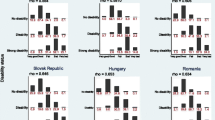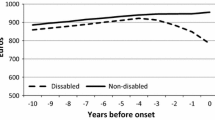Abstract
This paper studies the relationship between having a disability and unemployment duration by focusing on individuals registered at Portuguese job centers. Despite its relevance, because disabled people are likely to occupy disadvantaged positions in the labor market, it has received little attention in the literature. As different disabilities affect unemployment duration differently, we distinguish different types of disabilities and shed light on disability-specific support policies. We apply a discrete time hazard model with unobserved heterogeneity to microdata from the Instituto do Emprego e Formação Profissional, which are free from self-reporting problems in disability identification. We find lower reemployment probabilities for many groups of disabled people: individuals with impairment in general functions, disfiguring, speech and visual disorders, muscle-skeletal and other organ impairments experience the more disadvantaged positions. Decomposition analysis indicates that part of the disadvantage is due to differences in returns rather than to differences in characteristics. These findings suggest that the disadvantage of disabled people in the labor market is not only explained by a different distribution of characteristics but especially by the interaction of their characteristics with the work environment. Policy implications are discussed.

Similar content being viewed by others
Notes
Specifically, a binary dependent variable was created. If the individual i’s survival time is censored, then the dependent binary variable always has a value of zero; if the individual i’s survival time is not censored, then the dependent binary variable has a value of zero in the first j-1 observation and has a value of one in the last observation.
At least for a single spell (or independent spells), Nicoletti and Rondinelli (2006) show that in discrete time hazard models, assuming Gaussian unobserved heterogeneity, misspecifying the error distribution only leads to an equiproportional rescaling of the covariate coefficients.
Estimation results using models without unobserved heterogeneity and/or alternative baseline hazard assumptions are available upon request.
Assuming alternative weighting matrices allows us to formulate the decomposition from alternative viewpoints. If Ω = 1, then \( \tilde{b} = {b_D} \) and the differences in characteristics are weighted by the returns of disabled people. If Ω = 0, then \( \tilde{b} = {b_{{NDS}}} \) and the differences in characteristics are weighted by the returns of non-disabled people.
In 2000, the Portuguese Government adopted a system of quotas with respect to the employment of disabled persons in the Public Administration.
To increase job-finding rates for disabled people, the New Code of Labor (Lei 99/03) favored the adaptation of tasks and measures and the promotion of adequate vocational training (The Report of Activity of IEFP 2002).
The IEFP is the agency responsible for running the public employment services and is a division of the Ministry of Labor and Solidarity.
For comparison purposes, we draw two other 10% randomized sub-samples. Descriptive statistics and duration analysis results are available upon request.
The IEFP data has no full information about the contractual form (permanent or temporary contract) reached after unemployment spells; hence, we are unable to conduct a competing risks analysis.
Unfortunately, IEFP data do not provide information about the origin of disability (congenital or acquired), which is likely to affect the lives of disabled people.
Absenteeism or failure rates diverge between non-disabled (0.81%) and disabled people (3.10%).
IEFP data also do not provide information about the seriousness or worsening of a disability. This also may produce shifts in the individual hazard rate that we cannot control.
To construct the stock values of unemployment and vacancies, we use information from the IEFP dataset dating back to January 1997 to accumulate flow values and to construct stocks for the period under analysis, which is from 1998 onwards.
For brevity, the estimation results obtained by the logistic specification of the hazard rate are not presented, as no noteworthy differences emerged.
Estimation results from the other two non-disabled people sub-groups are consistent with the estimation results that we report here. Predicted hazard rates are also strongly comparable. They are both available upon request.
Table 8 may be interpreted as follows: Compare, for example, disabled people with MSK problems and non-disabled people (NDS). The raw hazard rate differential, which is the left-side of Eq. 4 (h MSK – h NDS ), is −0.00733. Thus, the MSK group experiences, on average, a hazard rate lower by 0.00733 than NDS. Decomposition analysis decomposes the raw differential in two parts: characteristics and returns. The returns part, when comparing MSK and NDS, is −0.00505 and −0.00459, which are according to the value of the weighting matrix. Thus, between 0.00459 and 0.00505 of the raw differential between MSK and NDS is explained by lower differences in returns of individual characteristics.
References
Baldwin ML (1999) The effects of impairments on employment and wages: estimates from the 1984 and 1990 SIPP. Behav Sci Law 17:7–27
Bartel A, Taubman P (1979) Health and labour market success: the role of various diseases. Rev Econ Stat 59(1):1–8
Bauer TK et al (2008) Gender differences in smoking behaviour. Health Econ 16:895–909
Bauer TK, Sinning M (2008) An extension of the Blinder-Oaxaca decomposition to nonlinear models. Asta, Adv Stat Anal 92:197–206
Blanchard OJ, Diamond P (1994) Ranking, unemployment duration and wages. Rev Econ Stud 61:417–434
Buddelmeyer H (2001) Re-employment dynamics of disabled workers. IZA Discussion Paper Series 2001; n. 269. Institute for the Study of Labor, Bonn
Campolieti M (2002) Disability and the labor force participation of older men in Canada. Lab Econ 9(1):405–432
European Commission (2001) The Employment Situation of Persons with Disabilities in the European Union. 2005; http://ec.europa.eu/employment_social/publications/2001/cev501003en.pdf
Gannon B (2005) A dynamic analysis of disability and labour force participation in Ireland 1995–2000. Health Econ 14(9):925–938
IEFP (2002) Report of activity
Instituto Nacional de Estatística. Census (2001)
Jenkins S (2005) Survival analysis. University of Essex
Kidd M et al (2000) Disability and the labour market: an analysis of British males. J Health Econ 19:961–981
Lindeboom M et al (2006) Disability and work: the role of health shocks and childhood circumstances. IZA discussion paper 2006; n. 2096. Institute for the study of Labor, Bonn
Linn MW et al (1985) Effects of unemployment on mental and physical health. Am J Public Health 75:502–506
Melkersson M (1999) Unemployment duration and heterogeneous search behaviour among Swedish disabled workers. Working Papers Series 1999; n. 5. IFAU, Uppsala
Miranda H (2003) Disability management in the Netherlands. Peer Review Programme of the European Employment Strategy, Den Haag, The Netherlands 24–25th November 2003
Nicoletti C, Rondinelli C (2006) The (Mis)specification of discrete time duration models with unobserved heterogeneity: a Monte Carlo Study. ISER Working Paper 2006, n. 53
Oaxaca RL, Ransom MR (1994) On discrimination and the decomposition of wage differentials. J Econometrics 61(1):5–21
Orlando N, Patrizio M (2006) Il Collocamento Mirato dei Disabili: L’Applicazione della Legge 68/1999 nella Provincia Autonoma di Bolzano. In: Parodi G (ed) Aspetti Socio-Economici della Disabilità: Atti del Convegno, Pescara Marzo 2006. Aracne, Roma
Petrongolo B, Pissarides CA (2001) Looking into the black box: a survey of the matching function. J Econ Lit 39:390–431
Prentice R, Gloeckler L (1978) Regression analysis of grouped survival data with application to breast cancer data. Biometrics 34(1):57–67
Stankunas M et al (2006) Duration of unemployment and depression: a cross-sectional survey in Lithuania. BMC Public Health 6:174–183
Acknowledgement
We are very grateful to two anonymous referees for useful suggestions. We also wish to thank the participants at the I International Workshop on Economics, Disability and Employment (Madrid, Spain) and at the seminar held at the Department of Economics, University of Modena and Reggio Emilia (Modena, Italy) for useful discussions. The usual disclaimer applies.
Author information
Authors and Affiliations
Corresponding author
Rights and permissions
About this article
Cite this article
Sciulli, D., de Menezes, A.G. & Vieira, J.C. Unemployment Duration and Disability: Evidence from Portugal. J Labor Res 33, 21–48 (2012). https://doi.org/10.1007/s12122-011-9120-y
Published:
Issue Date:
DOI: https://doi.org/10.1007/s12122-011-9120-y




